The 2002 Remodelers' Show
Interesting products and impressive speakers make the Indianapolis trade show well worth the trip
If you listened to the exhibitors at this year’s Remodeler’s Show in Indianapolis (Oct. 31-Nov. 2), you mostly heard grousing about low attendance. For them, foot traffic rules. If lots of people come by your booth, it’s a good show. If they don’t, it’s not. For attendees, however, it’s a different story.
There were 58 workshops and seminars at this year’s show. we can’t claim to have seen them all, but every one we attended boasted a capacity crown captivated by a great speaker. Whether it was Victoria Downing talking about low-cost marketing, Shawn McCadden on liabilities and risk management or Joe Lstiburek on moisture and mold, in every case remodelers walked away with tips they could put to work immediately.
We can’t remember ever being more impressed by the seminars at a trade show. Next year’s show is Oct. 22-25 in Baltimore (go to www.remodelersshow.comto learn more).
Interesting products can also make a show worth the trip, and there were a few on display in Indianapolis. Here are the ones that stood out for us as we walked the floor.
A new way to organize the garage
Up to now, home builders have given less thought to the garage than to any other room in the house: Throw up some drywall, maybe finish the walls, but after that it’s up to the client to figure out how to use the space. That’s about to change, thanks to Gladiator Garageworks, a garage organizing system that was unveiled for the first time at the 2002 Remodeler’s Show.
The centerpiece of the system is a 1-ft. by 8-ft. corrugated plastic (CPVC ) wall panel that’s applied over the studs instead of drywall. These GearWall panels, as they call them, are built with channels that accept a number of different hooks and baskets. Much like a high-tech peg-board, the GearWall panels allow items such as tools, bicycles and sporting goods to be hung anywhere on the walls.
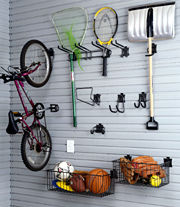
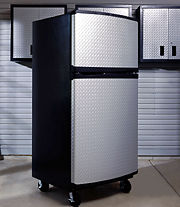
The Gladiator system includes wall-mounted cabinets and shelves, as well as a full complement of floor-mounted garage components: Workbench, locker, shelving, even heavy-duty appliances such as a trash compactor and a refrigerator that features a heating element to make sure your beer doesn’t freeze in the winter.
The manufacturer hopes that home builders will see the Gladiator system as a way to offer their buyers a useful (and profitable) upgrade. To accommodate existing garages, the GearWall panels can be mounted overtop drywall as well as bare studs.
Gladiator Garageworks is a subsidiary of Whirlpool Corporation. For more information, call 866-342-4089 or visit the Web site: www.gladiatorgarageworks.com.
— Tom O’Brien
An alternative to soffit vents
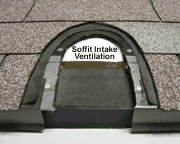
In case you didn’t know it, ridge vents are worthless by themselves. They are designed to exhaust hot air and moisture from the attic or from the rafter bays, but to work properly they need an intake vent. That’s where soffit vents come in. The trouble with soffit vents is that they can be ugly, and they’re tough to retrofit. Well, DCI Products, Inc. has an alternative that looks pretty interesting. It’s called the SmartVent.
SmartVent is a tapered plastic panel about 3 ft. long that’s installed on the roof deck underneath the first course of shingles. The leading edge of the corrugated panel is 3/4 in. thick, which allows air to enter. A woven material, similar to housewrap, keeps out rain and bugs while allowing air to enter. To install the SmartVent, you have to cut a 1-in. slot in the roof deck, then you simply nail the panels in place.
To learn more about SmartVent, along with DCI’s other ventilation products, visit www.dciproducts.com.
— Kevin Ireton
When you have to run utilities through the floor joists
Building codes and I-Joist manufacturers have very specific requirements for cutting and notching floor joists. But remodeling jobs often involve surprises: Like the time my clients waited until after the framing work was done, before they decided to add central air conditioning.
Used to be such changes involved job site meetings with lots of engineers. Now all it might take is a phone call to Metwood Building Solutions. Metwood’s standard Joist Reinforcer is a galvanized steel plate (with a hole in the middle) that allows large pipes or small ducts to pass through a 2×10 floor joist. The company representative I talked to during the Remodeler’s Show told me that this product has been accepted by BOCA as well as by the 1998 CABO One and Two-Family Dwelling Code.
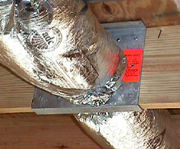
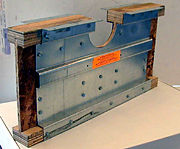
In addition to their off-the shelf products, Metwood also offers a custom design service: If you need to run a large HVAC duct through the web of an I-Joist, or if you need to notch the flange of an I-Joist, they will make the properly-sized joist reinforcer and provide an engineer’s letter to appease your building official.
For more information, call 540-334-4294, or visit www.metwood.com.
— Tom O’Brien
An attic stair like no other

Maybe it was the bright blue color, maybe it was the unusual design, but the Rainbow Attic Stair caught my eye from across the exhibit hall. Up close, I learned that the treads are supported by a pair of scissor-like mechanisms, made of powder-coated steel. It turns out that the bright colors (yellow, orange, blue, green, red) are used to distinguish the various sizes/models. But the design isn’t just eye catching, it also makes sense. The steel construction means a load capacity of 350 lb. And the scissor mechanism makes the stair self adjusting for ceiling height, so you don’t have to trim this stair the way you do conventional attic stairs.
Other features of this stair include a 4-ft. telescoping handrail, a pair of safety handles at the top and steel flange around the opening that eliminates the need for casing. But even more appealing, the integral door is insulated with 2 in. of foam, for an R-15 rating, and there’s a double row of vinyl-bulb weather-stripping around it. The stair even comes with four adjustable hangers that make installation as simple as tightening four nuts.
Admittedly a full-sized staircase would be the safest, most comfortable access for any attic, but since that’s just not an option in most homes, the Rainbow Attic Stair may be the next best thing. It comes in three rough-opening sizes and extends from 7 ft., 4 in. to 11 ft., 6 in., depending on model. Prices start at around $500. For more information, visit the manufacturers Web site at www.shelterproducts.net.
— Kevin Ireton
Kevin Ireton is Fine Homebuilding’s editor in chief; Tom O’Brien is an associate editor.
Photos and art courtesy of Gladiator Garageworks, DCI Products, Inc., Metwood Building Solutions, and Rainbow Attic Stair






















